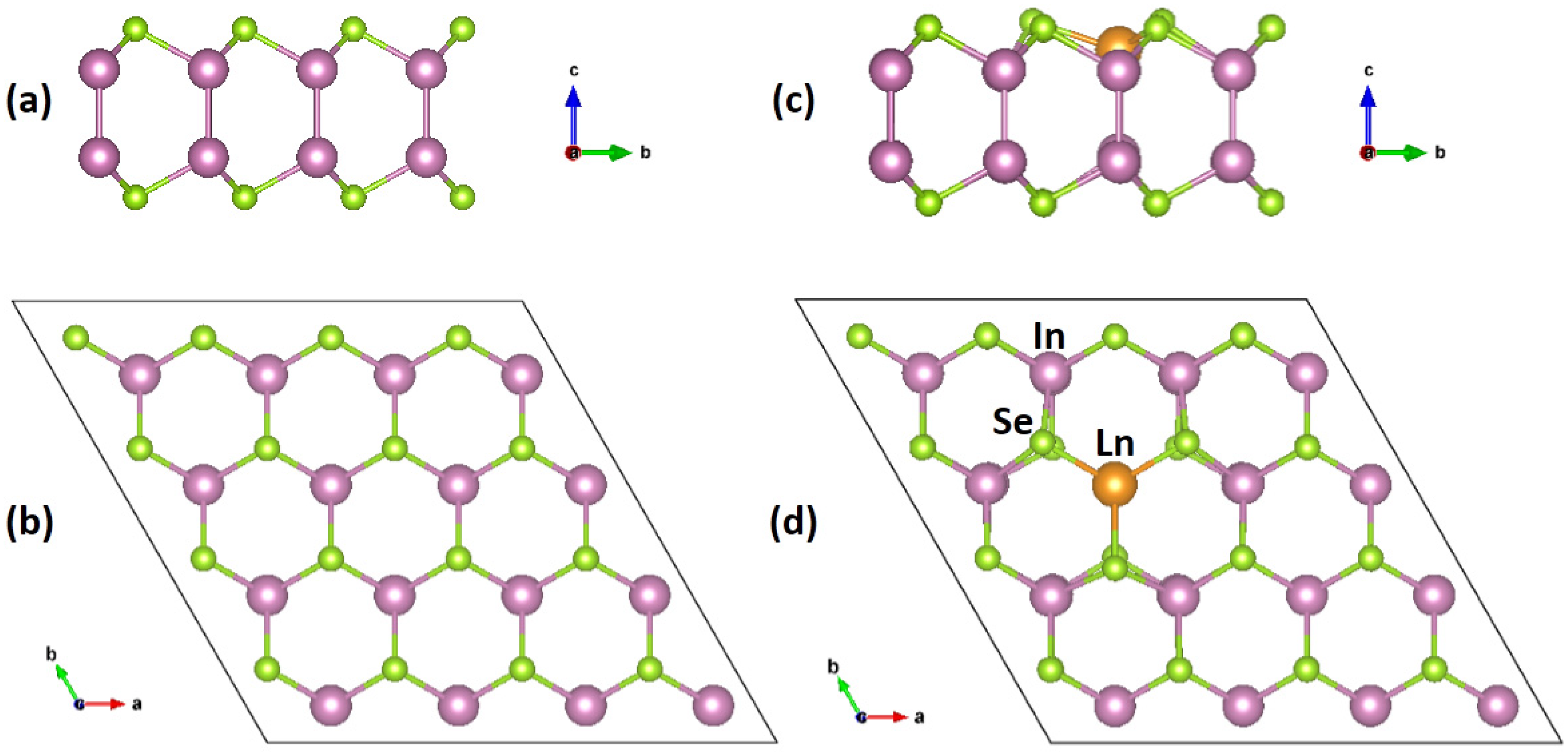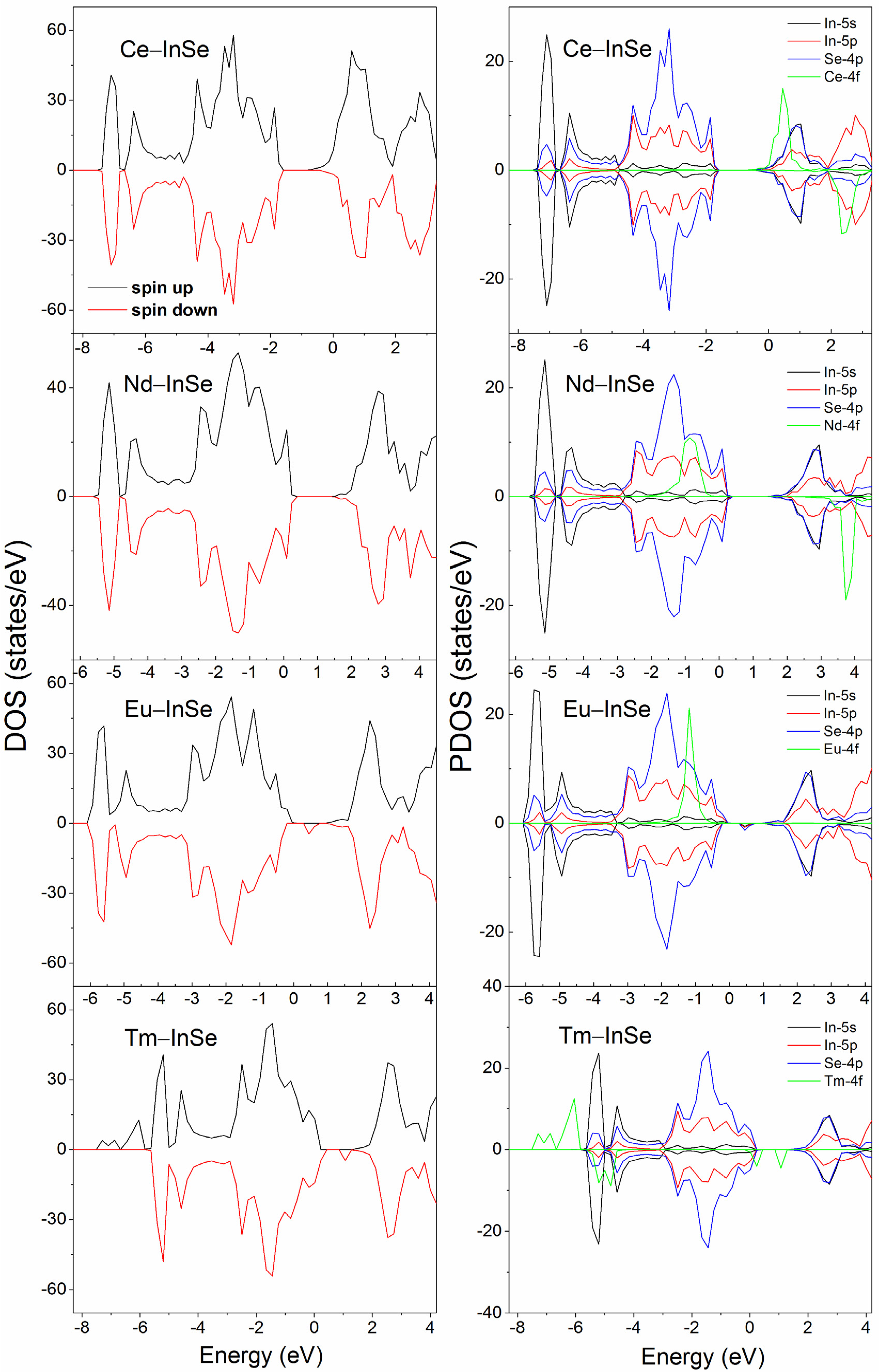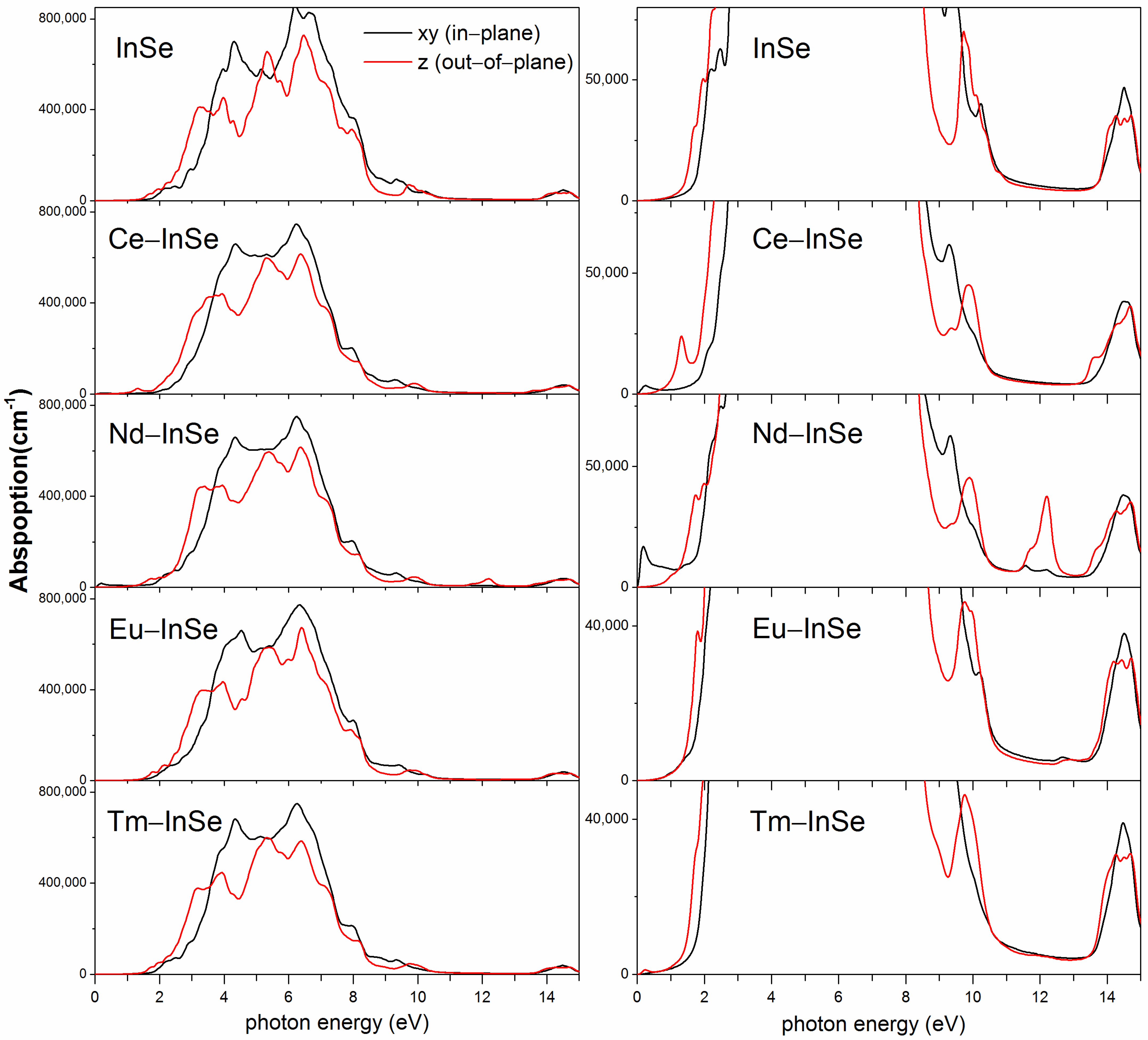Influence of Ce, Nd, Eu and Tm Dopants on the Properties of InSe Monolayer: A First-Principles Study
Abstract
:1. Introduction
2. Calculation Methodology
3. Results and Discussion
3.1. Structure and Magnetic Properties
3.2. Band Structure and Electronic Property
3.3. Optical Properties
4. Conclusions
Author Contributions
Funding
Institutional Review Board Statement
Informed Consent Statement
Data Availability Statement
Conflicts of Interest
References
- Novoselov, K.S.; Geim, A.K.; Morozov, S.V.; Jiang, D.; Zhang, Y.; Dubonos, S.V.; Grigorieva, I.V.; Firsov, A.A. Electric field effect in atomically thin carbon films. Science 2004, 306, 666–669. [Google Scholar] [CrossRef] [Green Version]
- Castro Neto, A.H.; Guinea, F.; Peres, N.M.R.; Novoselov, K.S.; Geim, A.K. The electronic properties of graphene. Rev. Mod. Phys. 2009, 81, 109. [Google Scholar] [CrossRef] [Green Version]
- Thomas, S.; Manju, M.S.; Ajith, K.M.; Lee, S.U.; Asle Zaeem, M. Strain-induced work function in h-BN and BCN monolayers. Phys. E 2020, 123, 114180. [Google Scholar] [CrossRef]
- Lin, Y.; Connell, J.W. Advances in 2D boron nitride nanostructures: Nanosheets, nanoribbons, nanomeshes, and hybrids with graphene. Nanoscale 2012, 4, 6908–6939. [Google Scholar] [CrossRef] [PubMed]
- Li, L.; Yu, Y.; Ye, G.J.; Ge, Q.; Ou, X.; Wu, H.; Feng, D.; Chen, X.H.; Zhang, Y. Black Phosphorus Field-effect Transistors. Nat. Nanotechnol. 2014, 9, 372–377. [Google Scholar] [CrossRef] [PubMed] [Green Version]
- Lopez-Sanchez, O.; Lembke, D.; Kayci, M.; Radenovic, A.; Kis, A. Ultrasensitive photodetectors based on monolayer MoS2. Nat. Nanotechnol. 2013, 8, 497–501. [Google Scholar] [CrossRef] [PubMed]
- Chen, F.; Yao, Y.; Su, W.; Zhao, S.; Ding, S.; Fu, L. The synthesis of 2D MoS2 flakes with tunable layer numbers via pulsed-Argon-flow assisted CVD approach. Ceram. Int. 2020, 46, 14523–14528. [Google Scholar] [CrossRef]
- Stefanatos, D.; Karanikolas, V.; Iliopoulos, N.; Paspalakis, E. Fast optically controlled spin initialization of a quantum dot in the Voigt geometry coupled to a transition metal dichalcogenide monolayer. Phys. E 2020, 118, 113935. [Google Scholar] [CrossRef]
- Cheng, L.; Yuan, C.; Shen, S.D.; Yi, X.; Gong, H.; Yang, K.; Liu, Z. Bottom-Up Synthesis of Metal-Ion-Doped WS₂ Nanoflakes for Cancer Theranostics. ACS Nano 2015, 9, 11090–11101. [Google Scholar] [CrossRef] [PubMed]
- Gazibegovic, S.; Car, D.; Zhang, H.; Balk, S.C.; Logan, J.A.; de Moor, M.W.A.; Cassidy, M.C.; Schmits, R.; Xu, D.; Wang, G.; et al. Epitaxy of advanced nanowire quantumdevices. Nature 2017, 548, 434–438. [Google Scholar] [CrossRef] [PubMed] [Green Version]
- Yoo, H.; Heo, K.; Ansari, H.R.; Cho, S. Recent Advances in Electrical Doping of 2D Semiconductor Materials: Methods, Analyses, and Applications. Nanomaterials 2021, 11, 832. [Google Scholar] [CrossRef]
- Xie, Z.; Cheng, W.D. First-principles study of electronic structure and optical properties of TiO2 nanotubes. Acta Phys. Sin. 2014, 63, 243102. [Google Scholar]
- Long, H.; Zeng, W.; Wang, H.; Qian, M.; Liang, Y.; Wang, Z. Self-assembled biomolecular 1D nanostructures for aqueous sodium-ion battery. Adv. Sci. 2018, 5, 1700634. [Google Scholar] [CrossRef] [PubMed] [Green Version]
- Mudd, G.W.; Svatek, S.A.; Ren, T.; Patanè, A.; Makarovsky, O.; Eaves, L.; Beton, P.H.; Kovalyuk, Z.D.; Lashkarev, G.V.; Kudrynskyi, Z.R. Tuning the bandgap of exfoliated InSe nanosheets by quantum confinement. Adv. Mater. 2013, 25, 5714–5718. [Google Scholar] [CrossRef] [PubMed] [Green Version]
- Mudd, G.W.; Molas, M.R.; Chen, X.; Zólyomi, V.; Nogajewski, K.; Kudrynskyi, Z.R.; Kovalyuk, Z.D.; Yusa, G.; Makarovsky, O.; Eaves, L. The direct-to-indirect band gap crossover in two-dimensional van der Waals Indium Selenide crystals. Sci. Rep. 2016, 6, 39619. [Google Scholar] [CrossRef] [PubMed] [Green Version]
- Camassel, J.; Merle, P.; Mathieu, H.; Chevy, A. Excitonic absorption edge of indium selenide. Phys. Rev. B 1978, 17, 4718–4725. [Google Scholar] [CrossRef]
- Zhao, Q.; Wang, W.; Carrascoso-Plana, F.; Jie, W.; Wang, T.; Castellanos-Gomez, A.; Frisenda, R. The role of traps in the photocurrent generation mechanism in thin InSe photodetectors. Mater. Horiz. 2020, 7, 252–262. [Google Scholar] [CrossRef] [Green Version]
- Yang, Z.; Jie, W.; Mak, C.H.; Lin, S.; Lin, H.; Yang, X.; Yan, F.; Lau, S.P.; Hao, J. Wafer-scale synthesis of high-quality semiconducting two-dimensional layered InSe with broadband photoresponse. ACS Nano 2017, 11, 4225–4236. [Google Scholar] [CrossRef]
- Lei, S.; Ge, L.; Najmaei, S.; George, A.; Kappera, R.; Lou, J.; Chhowalla, M.; Yamaguchi, H.; Gupta, G.; Vajtai, R. Evolution of the electronic band structure and efficient photo-detection in atomic layers of InSe. ACS Nano 2014, 8, 1263–1272. [Google Scholar] [CrossRef]
- Tamalampudi, S.; Lu, Y.; Kumar, R.; Sankar, R.; Liao, C.D.; Moorthy, K.; Cheng, C.H.; Chou, F.C.; Chen, Y.T. High performance and bendable fewlayered InSe photodetectors with broad spectral response. Nano Lett. 2014, 14, 2800–2806. [Google Scholar] [CrossRef]
- Bandurin, D.A.; Tyurnina, A.V.; Yu, G.L.; Mishchenko, A.; Zólyomi, V.; Morozov, S.V.; Kumar, R.K.; Gorbachev, R.V.; Kudrynskyi, Z.R.; Pezzini, S.; et al. High electron mobility, quantum Hall effect and anomalous optical response in atomically thin InSe. Nat. Nanotechnol. 2017, 12, 223–227. [Google Scholar] [CrossRef] [PubMed]
- Feng, W.; Zheng, W.; Cao, W.; Hu, P.A. Back gated multilayer InSe transistors with enhanced carrier mobilities via the suppression of carrier scattering from a dielectric interface. Adv. Mater. 2014, 26, 6587–6593. [Google Scholar] [CrossRef]
- Dai, M.; Chen, H.; Wang, F.; Hu, Y.; Wei, S.; Zhang, J.; Wang, Z.; Zhai, T.; Hu, P.A. Robust Piezo-Phototronic Effect in Multilayer gamma-InSe for High-Performance Self-Powered Flexible Photodetectors. ACS Nano 2019, 13, 7291–7299. [Google Scholar] [CrossRef] [PubMed]
- Fang, Q.; Zhao, X.; Huang, Y.; Xu, K.; Min, T.; Chu, P.K.; Ma, F. Structural stability and magnetic-exchange coupling in Mn-doped monolayer/bilayer MoS2. Phys. Chem. Chem. Phys. 2018, 20, 553–561. [Google Scholar] [CrossRef] [PubMed]
- Li, X.; Xia, C.; Song, X.; Du, J.; Xiong, W. N- and p-type dopants in the InSe monolayer via substitutional doping. J. Mater. Sci. 2017, 52, 7207–7214. [Google Scholar] [CrossRef]
- Fu, Z.; Yang, B.; Zhang, N.; Lu, Z.; Yang, Z.; Ma, D. Tuning the physical and chemical properties of 2D InSe with interstitial boron doping: A first-principles study. J. Phys. Chem. C 2017, 121, 28312–28316. [Google Scholar] [CrossRef]
- Sun, Y.N.; Wang, X.F.; Zhai, M.X.; Yao, A.L. Tunable magnetism and metallicity in As-doped InSe quadruple layers. J. Phys. D Appl. Phys. 2017, 50, 215003. [Google Scholar] [CrossRef]
- Wang, T.; Li, J.; Jin, H.; Wei, Y. Tuning the electronic and magnetic properties of InSe nanosheets by transition metal doping. Phys. Chem. Chem. Phys. 2018, 20, 7532–7537. [Google Scholar] [CrossRef]
- Li, X.; Xia, C.; Du, J.; Xiong, W. Magnetism induced by 3d transition metal atom doping in InSe monolayer. J. Mater. Sci. 2018, 53, 3500–3508. [Google Scholar] [CrossRef]
- Qin, X.; Liu, X.; Huang, W.; Bettinelli, M.; Liu, X. Lanthanide-activated phosphors based on 4f-5d optical transitions: Theoretical and experimental aspects. Chem. Rev. 2017, 117, 4488–4527. [Google Scholar] [CrossRef]
- Mitchell, B.; Dierolf, V.; Gregorkiewicz, T.; Fujiwara, Y. Perspective: Toward efficient GaN-based red light emitting diodes using europium doping. J. Appl. Phys. 2018, 123, 160901. [Google Scholar] [CrossRef] [Green Version]
- Pavón, F.; Urbieta, A.; Fernández, P. Luminescence and light guiding properties of Er and Li codoped ZnO nanostructures. J. Lumin. 2018, 195, 396–401. [Google Scholar] [CrossRef]
- Su, B.; Li, N. Lanthanide atom substitutionally doped blue phosphorene: Electronic and magnetic behaviors. Phys. Chem. Chem. Phys. 2018, 20, 11003–11012. [Google Scholar] [CrossRef] [PubMed]
- Bai, G.; Yuan, S.; Zhao, Y.; Yang, Z.; Choi, S.Y.; Chai, Y.; Yu, S.F.; Lau, S.P.; Hao, J. 2D layered materials of rare-earth Er-doped MoS2 with NIR-to-NIR down- and up-conversion photoluminescence. Adv. Mater. 2016, 28, 7472–7477. [Google Scholar] [CrossRef]
- Ouma, C.N.M.; Singh, S.; Obodo, K.O.; Amolod, G.O.; Romero, A.H. Controlling the magnetic and optical responses of a MoS2 monolayer by lanthanide substitutional doping: A first-principles study. Phys. Chem. Chem. Phys. 2017, 19, 25555–25563. [Google Scholar] [CrossRef] [PubMed]
- Obodo, K.O.; Gebreyesus, G.; Ouma, C.N.M.; Obodo, J.T.; Ezeonu, S.O.; Rai, D.P.; Bouhafs, B. Controlling the electronic and optical properties of HfS2 mono-layers via lanthanide substitutional doping: A DFT + U study. RSC Adv. 2020, 10, 15670–15676. [Google Scholar] [CrossRef] [Green Version]
- Patra, B.; Jana, S.; Constantin, L.A.; Samal, P. Relevance of the Pauli kinetic energy density for semilocal functionals. Phys. Rev. B 2019, 100, 155140. [Google Scholar] [CrossRef]
- Patra, A.; Patra, B.; Constantin, L.A.; Samal, P. Electronic band structure of layers within meta generalized gradient approximation of density functionals. Phys. Rev. B 2020, 102, 045135. [Google Scholar] [CrossRef]
- Xie, Z.; Lin, S.; Wang, Z. Electronic structure and magnetism in transition metal doped InSe monolayer: A GGA + U study. Ceram. Int. 2018, 44, 15912–15917. [Google Scholar] [CrossRef]
- Cen, W.; Liu, Y.; Wu, Z.; Wang, H.; Weng, X. A theoretic insight into the catalytic activity promotion of CeO2 surfaces by Mn doping. Phys. Chem. Chem. Phys. 2012, 14, 5769–5777. [Google Scholar] [CrossRef]
- Hu, T.; Zhou, J.; Dong, J. Strain induced new phase and indirect–direct band gap transition of monolayer InSe. Phys. Chem. Chem. Phys. 2017, 19, 21722–21728. [Google Scholar] [CrossRef] [PubMed]
- Speight, J.G. Lange’s Handbook of Chemistry, 16th ed.; McGraw-Hill: New York, NY, USA, 2005; pp. 1.151–1.156. [Google Scholar]
- Wang, Z.; Zeng, W.; Gu, L.; Saito, M.; Tsukimoto, S.; Ikuhara, Y. Atomic-scale structure and electronic property of the LaAlO3/TiO2 interface. J. Appl. Phys. 2010, 108, 113701. [Google Scholar] [CrossRef]
- Kumar, A.; Ahluwalia, P.K. A first principle Comparative study of electronic and optical properties of 1H–MoS2 and 2H–MoS2. Mater. Chem. Phys. 2012, 135, 755–761. [Google Scholar] [CrossRef]
- Terentjev, A.V.; Constantin, L.A.; Pitarke, J.M. Gradient-dependent exchange-correlation kernel for materials optical properties. Phys. Rev. B 2018, 98, 085123. [Google Scholar] [CrossRef] [Green Version]
- Wu, M.; Shi, J.; Zhang, M.; Ding, Y.; Wang, H.; Cen, Y.; Lu, J. Enhancement of photoluminescence and hole mobility in 1- to 5-layer InSe due to the top valence-band inversion: Strain effect. Nanoscale 2018, 10, 11441–11451. [Google Scholar] [CrossRef]





| System | ΔEf (eV) | Mtot (μB) | MLn (μB) | DLn–Se (Å) | DLn–In (Å) | |
|---|---|---|---|---|---|---|
| In-Rich | Se-Rich | |||||
| Ce-doped | −1.697 | −2.743 | 0.973 | 0.998 | 2.83 | 3.29 |
| Nd-doped | −1.379 | −2.425 | 2.948 | 3.025 | 2.80 | 3.25 |
| Eu-doped | −0.670 | −1.716 | 7.528 | 7.027 | 2.87 | 3.45 |
| Tm-doped | −0.878 | −1.923 | 1.945 | 1.889 | 2.71 | 3.16 |
| InSe | / | / | 0 | 0 | 2.69 | 2.82 |
Publisher’s Note: MDPI stays neutral with regard to jurisdictional claims in published maps and institutional affiliations. |
© 2021 by the authors. Licensee MDPI, Basel, Switzerland. This article is an open access article distributed under the terms and conditions of the Creative Commons Attribution (CC BY) license (https://creativecommons.org/licenses/by/4.0/).
Share and Cite
Xie, Z.; Chen, L. Influence of Ce, Nd, Eu and Tm Dopants on the Properties of InSe Monolayer: A First-Principles Study. Nanomaterials 2021, 11, 2707. https://doi.org/10.3390/nano11102707
Xie Z, Chen L. Influence of Ce, Nd, Eu and Tm Dopants on the Properties of InSe Monolayer: A First-Principles Study. Nanomaterials. 2021; 11(10):2707. https://doi.org/10.3390/nano11102707
Chicago/Turabian StyleXie, Zhi, and Limin Chen. 2021. "Influence of Ce, Nd, Eu and Tm Dopants on the Properties of InSe Monolayer: A First-Principles Study" Nanomaterials 11, no. 10: 2707. https://doi.org/10.3390/nano11102707




